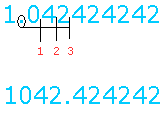Converting repeating decimals to fractions
When converting repeating decimals to fractions, just follow the five steps below carefully.Let x equal the repeating decimal you are trying to convert to a fraction.
Step 2:
Examine the repeating decimal to find the repeating digit(s).
Step 3:
Place the repeating digit(s) to the left of the decimal point.
Step 4:
Place the repeating digit(s) to the right of the decimal point.
Step 5:
Using the two equations you found in step 3 and step 4, subtract the left sides of the two equations. Then, subtract the right sides of the two equations
As you subtract, just make sure that the difference is positive for both sides.
Now let's practice converting repeating decimals to fractions with two good examples.
Example #1:
What rational number or fraction is equal to 0.55555555555
Step 1:
x = 0.5555555555
Step 2:
After examination, the repeating digit is 5.
Step 3:
To place the repeating digit ( 5 ) to the left of the decimal point, you need to move the decimal point 1 place to the right.
Technically, moving a decimal point one place to the right is done by multiplying the decimal number by 10.
When you multiply one side by a number, you have to multiply the other side by the same number to keep the equation balanced.
Thus, 10x = 5.555555555
Step 4:
Place the repeating digit(s) to the right of the decimal point.
Look at the equation in step 1 again. In this example, the repeating digit is already to the right, so there is nothing else to do.
x = 0.5555555555
Step 5:
Your two equations are:
10x = 5.555555555
x = 0.5555555555
10x - x = 5.555555555 − 0.555555555555
9x = 5
Divide both sides by 9.
x = 5/9
Example #2:
What rational number or fraction is equal to 1.04242424242
Step 1:
x = 1.04242424242
Step 2:
After examination, the repeating digit is 42.
Step 3:
To place the repeating digit ( 42 ) to the left of the decimal point, you need to move the decimal point 3 places to the right.

When you multiply one side by a number, you have to multiply the other side by the same number to keep the equation balanced
Thus, 1000x = 1042.42424242
Step 4:
Place the repeating digits to the right of the decimal point.
In this example, the repeating digit is not immediately to the right of the decimal point.
Look at the equation in step 1 one more time and you will see that there is a zero between the repeating digit and the decimal point.
To accomplish this, you have to move the decimal point 1 place to the right.

This is done by multiplying both sides by 10.
10x = 10.4242424242
Step 5:
Your two equations are:
1000x = 1042.42424242
10x = 10.42424242
1000x - 10x = 1042.42424242 − 10.42424242
990x = 1032
Divide both sides by 990
x = 1032/990
To master this lesson about converting repeating decimals to fractions, you will need to study the two examples above carefully and practice with other examples.
Common pitfalls to avoid when converting repeating decimals to fractions
- Forgetting to put the decimal point right before the repeating digit(s).
- When subtracting the two equations, forgetting to subtract the smaller one from the bigger one.
- Not keeping good track of the number of places the decimal point was moved.
- Thinking that the repeating digit(s) is 8 if the decimal is 0.08